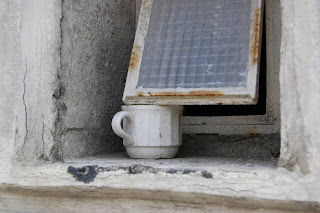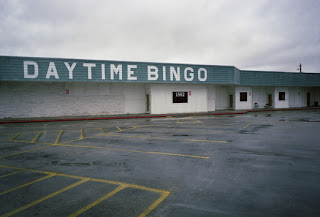My initial influence of the body unit is the photographer Loretta Lux whose work I first discovered on a postcard titled 'Ophelia, 2005' in the National Portrait Gallery; and after looking further into her other works have fallen in love with her work and techniques.
 |
| Ophelia, 2005 |
Many of her images are quite surreal due to the unusual and unique artistic methods Lux uses to edit her images often hand painting the prints to give the subjects smooth, porcelain-like complexions. It gives a neutral cupid like skin tone which could have been inspired by paintings by artists such as William Bouguereau where child-like figures are portrayed as innocent, fragile figures.
 |
| 'Cupid and Psyche as Children, 1890' |
Her work looks at underlying themes of changing levels of innocence and the loss of it through adolescence; however I want to focus more closely on the more neutrally toned and plainly composed images of young children.
I really like the blank canvas lookof the backdrops in many of Lortetta Lux's images enhancing this sense of purity; although the perfectly composed children staring into the camera lens gives a slightly eerie edge to many of the portraits. Playing on the idea of when a person is innocent, when it is lost and what it is.
 |
| 'Isabel' |
The neutral, pastel tones of the colour palette also highlight what society sees as innocent but it still gives a stark feel to the photographs therefore leaves the audience slightly uneasy about the subject matter.
During my Body tutorial I was introduced to the photographer Vee Speers whose work 'The Birthday Party' has also fascinated me in the way that she has composed and lit the figures.
 |
| 'The Birthday Party' |
Again the set up is in ways very similar to that of Loretta Lux's work, the children are centrally positioned staring mostly directly at the audience creating quite a tense eerie scene.
She initially came up with the idea of this series when watching her children and friends at a fancy dress party; Speers worked with the individual children to choose their outfits for the shoot asking them to choose what they wanted to be. Some chose princesses and angels however others chose more disturbing characters such as hunters and soldiers. This plays on the idea of adulthood coming early to children ruining the idea of innocence.
She looks a little at child psychology explaining how costume choices can expose underlying traumas and issues that the child has referring to escapism from the real world which gives a sense that children are not so innocent.
Her images are again quite flat as there is little tone trying to reflect childhood innocence in the colour palette. I also like the clothing choices as in most of the images the costumes are quite bland but his contrasted with a prop, such as a dead black bird or a boxing glove drawing the viewers attention more starkly to the artist's message.
I then decided to revisit a favourite photographer of mine, Sally Mann whose 'controversial' work is very inspirational to me.
Her pictures depict her three children playing at their remote summer cabin by a river; often photographed naked Mann exposes her family to the public from the viewpoint of a mother. Many of her images show children as children playing, reading, dressing up being 'innocent' to the world around them while others delve further in to themes of insecurity, illness and death which is definitely not associated with the purity.
Angry accusations of child pornography met the artist when her photographs were first exposed to the public and media, the Wall Street Journal was seen censoring an image of her daughter, Virginia with black strips over her eyes, chest and pubic area. Sally Mann has commented saying herself that she feels that her images are natural through the eyes of a mother and critics agreed saying, 'her vision in large measure (is) accurate, and a
welcome corrective to familiar notions of youth as a time of unalloyed
sweetness and innocence'.
Many of her shots look natural however are often set up much like Lux and Speers images however the setting is much more relaxing and peaceful reflecting the message of innocence in her subject matter. Due to the huge publicity and accusations when her work first came out it is hard to look at her images and not feel this underlying sinister tones purely manifested through the media.
Although none of her images are edited the soft lighting makes the children's nude skin look smooth and flawless.
While doing further reserach I came across a pair of photographers who collectively call themselves Billy & Hells. The German photographers are actually called Anke Linz and Andreas Oettinger; inspired by Diane Arbus, Irving Penn and Richard Avedon they began working as fashion photographers.
Billy & Hells use quite diffused lighting and reduced colour to create a neutral palette which often gives their images a slightly dirty tone. The models, although not young, are taken out of their natural environment and put in front of a neutral backdrop staring down the lens which could make the audience a little uncomfortable.
The figures look relatively young as though they could be going through adolescence which could again play with the idea as to what age you lose your innocence and therefore what it actually is. There images almost document the girls by the way they are plainly photographed with minimal shadow or harsh lighting.
Leading on from my research into Loretta Lux and Vee Speers' work I discovered the photographer Davina Feinberg who take on a similar method of working as Lux. Her work looks at both child innocence and pure beauty, which she believes can be found in babies. The series titled 'Enameled' focusses on one year old girls with blond hair and blue eyes, a slightly sadistic view of idealized beauty.
Feinberg captures the innocent gestures of the babies as they sit for her, within a very controlled flat environment with what seems like no shadow which could be interpreted as the loss of innocence.
She manipulates the images given the babies an extremely pale complexion with rosy cheeks like a doll and piercing blue eyes staring into the camera associated with a sense of naivety and perfection; however so 'perfect' I feel they begin to look alien-like, so edited that they're not natural anymore which contradicts the message of beauty.
Although not perfect in the sense that Feinberg defines the word this next set of images by German photographer Bettina Von Zwohl depicts again a set of one-year-old babies in an environment where they are perfectly composed.
She captures their profile in a moment of concentration again in quite a documentary style with very flat lighting. The series 'Profile III' depicts, in a very controlled setting, an everyday scene of a child when absorbed by something.
The closeness of the camera gives quite an intimate feel to the images creating a sense of innocence, as if the children are sat so concentrated on whats going on out of frame they do not notice the audience studying them.
Von Zwehl says, 'They sat on a table, looking at me, and I took the picture with a long
cable release, since many of the babes were still too wriggly to
photograph, it took more than a year to get six final portraits. I was hoping to present each baby as an intelligent human
being.' Again her work plays on this idea as to what is innocence, as I feel that once we are aware of our surroundings, demonstrated in her images, we are not quite innocent to the world.
I want to use the work of these photographers to create similar lighting and clothing to investigating the meaning of innocence. I will also look more closely at the symbolism of innocence including, the colour white, a lamb referring to Jesus as the Lamb of God, children, virginity and nudity; all of which have been explored in one way or another in the above work.
The only issue I am having with this unit is the matter of finding a model as I really want to photograph a young model between the ages of about 5 and 10; however as presumed the public are not very open to the idea of allowing me to photograph their child in a studio setting. I'm not entirely sure how to tackle this problem in such a short time scale without jeopardising my final results.





























































